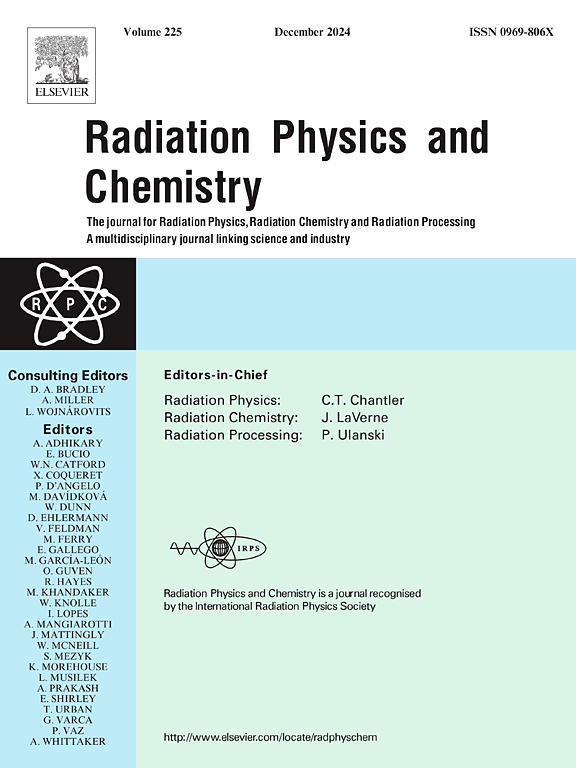Extravasation Modeling from a CT/PET Imaging for a Possible Digital Twin Approach
IF 2.8
3区 物理与天体物理
Q3 CHEMISTRY, PHYSICAL
引用次数: 0
Abstract
Extravasation of radiopharmaceuticals during PET procedures can compromise both diagnostic accuracy and patient safety by altering tracer pharmacokinetics and delivering unintended local radiation doses. A clinically observed 18F-FDG extravasation case has been reconstructed through a superposition of co-recorded CT and PET DICOM scan images to localize and quantify the extravasated activity. Building on advances in personalized computational modeling, the Digital Twin paradigm could offer a powerful framework for patient-specific dosimetry. Anatomical segmentation has been performed using Synopsys® Simpleware™ Medical to generate an accurate 3D model of the injection site and surrounding tissues. This Digital Twin has been completed through the build-up of an Unstructured Mesh domain that can be studied with the MCNP6© Monte Carlo code for particle transport simulations, incorporating the effective half-life of 18F-FDG to reflect dynamic radiotracer clearance. The digital twin has been benchmarked through OLINDA/EXM® code and thanks to dose-rate measurement performed with the Thermo Fisher Scientific Inc.© RadEye SPRD detector directly on the oncological injected patient. By embodying a patient’s anatomy, physiology, and radiotracer kinetics in a digital twin, this methodology provides a robust tool for personalized dosimetry of extravasation events. The framework is readily extensible to other radiopharmaceuticals and therapeutic contexts, supporting safer and more effective nuclear medicine practices.从CT/PET成像中建立外溢模型用于可能的数字孪生入路
PET过程中放射性药物的外渗会改变示踪剂的药代动力学并产生意想不到的局部辐射剂量,从而损害诊断的准确性和患者的安全。通过叠加CT和PET DICOM扫描图像重建临床观察到的18F-FDG外渗病例,以定位和量化外渗活动。基于个性化计算建模的进步,数字孪生范式可以为患者特异性剂量学提供一个强大的框架。使用Synopsys®Simpleware™Medical进行解剖分割,生成注射部位和周围组织的精确3D模型。这个数字双胞胎已经通过建立一个非结构化网格域完成,可以用MCNP6©蒙特卡罗代码进行粒子输运模拟,结合18F-FDG的有效半衰期来反映动态放射性示踪剂间隙。数字孪生体通过OLINDA/EXM®代码进行基准测试,并通过Thermo Fisher Scientific Inc.©RadEye SPRD检测器直接在肿瘤注射患者上进行剂量率测量。通过在数字双胞胎中体现患者的解剖、生理和放射性示踪剂动力学,该方法为外渗事件的个性化剂量测定提供了一个强大的工具。该框架很容易扩展到其他放射性药物和治疗环境,支持更安全和更有效的核医学实践。
本文章由计算机程序翻译,如有差异,请以英文原文为准。
求助全文
约1分钟内获得全文
求助全文
来源期刊

Radiation Physics and Chemistry
化学-核科学技术
CiteScore
5.60
自引率
17.20%
发文量
574
审稿时长
12 weeks
期刊介绍:
Radiation Physics and Chemistry is a multidisciplinary journal that provides a medium for publication of substantial and original papers, reviews, and short communications which focus on research and developments involving ionizing radiation in radiation physics, radiation chemistry and radiation processing.
The journal aims to publish papers with significance to an international audience, containing substantial novelty and scientific impact. The Editors reserve the rights to reject, with or without external review, papers that do not meet these criteria. This could include papers that are very similar to previous publications, only with changed target substrates, employed materials, analyzed sites and experimental methods, report results without presenting new insights and/or hypothesis testing, or do not focus on the radiation effects.
 求助内容:
求助内容: 应助结果提醒方式:
应助结果提醒方式:


